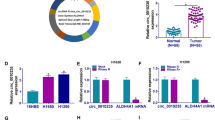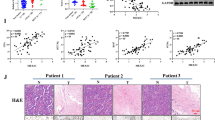Abstract
Cullin 3 (CUL3), a molecular scaffold of Cullin-RING ubiquitin ligase, plays an important role in regulating biological processes through modulating the ubiquitylation and degradation of various protein substrates. Dysfunction of CUL3 is implicated in the development of several human diseases. However, the clinical significance and prognostic value of CUL3 in lung cancer have not been investigated. This study investigated the CUL3-modulating potential of non-small cell lung cancer cell lines, H1299, H358, H2170 and H520, by using immunoblotting, MTT, migration, invasion, colony formation and in vivo tumorigenicity assays. The prognostic significance of CUL3 was measured by public KM plotter database (http://kmplot.com/analysis/index.php?p=service&cancer=breast) and tissue immunohistochemistry analysis. The public online database analysis revealed that elevated mRNA expression of CUL3 was associated with better prognosis for non-small cell lung cancer and lung adenocarcinoma. In vitro experiments showed that ectopic overexpression of CUL3 significantly inhibited lung adenocarcinoma cell proliferation and migration, and the tumor-suppressive effect of CUL3 was dependent on the Nrf2/RhoA axis. In vivo mice model demonstrated that overexpression of CUL3 lead to a significant reduction of lung adenocarcinoma growth and metastasis. Importantly, tissue immunohistochemistry analysis showed that about 47% of non-small cell lung cancer tissues were expressed of CUL3 at high levels. Overexpression of CUL3 predicted favorable overall survival in non-small cell lung cancer patients, especially in lung adenocarcinoma, but not in lung squamous cell carcinoma patients. CUL3 could serve as a prognostic biomarker for lung adenocarcinoma. Loss of CUL3 might be driving tumorigenesis by activating the Nrf2/RhoA pathway.






Similar content being viewed by others
Data availability
All data generated or analyzed during this study are included in this published article.
Abbreviations
- CUL3:
-
Cullin 3
- NSCLC:
-
Non-small cell lung cancer
- OS:
-
Overall survival
- CRLs:
-
Cullin-RING ubiquitin ligases
- Nrf2:
-
Nuclear factor erythroid 2-related factor
Reference
Siegel RL, Miller KD, Fedewa SA, Ahnen DJ, Meester RGS, Barzi A, Jemal A (2017) Colorectal cancer statistics. CA A Cancer J Clin 67(3):177–193
Chen W, Zheng R, Zhang S, Zhao P, Zeng H, Zou X (2014) Report of cancer incidence and mortality in China, 2010. Ann Transl Med 2(7):61
Genschik P, Sumara I, Lechner E (2013) The emerging family of CULLIN3-RING ubiquitin ligases (CRL3s): cellular functions and disease implications. EMBO J 32(17):2307–2320
Singer JD, Gurian-West M, Clurman B, Roberts JM (1999) Cullin-3 targets cyclin E for ubiquitination and controls S phase in mammalian cells. Genes Dev 13(18):2375–2387
Cheng J, Guo J, Wang Z, North BJ, Tao K, Dai X, Wei W (2018) Functional analysis of Cullin 3 E3 ligases in tumorigenesis. Biochim Biophys Acta Rev Cancer 1869(1):11–28
Tseng LA, Bixby JL (2011) Interaction of an intracellular pentraxin with a BTB-Kelch protein is associated with ubiquitylation, aggregation and neuronal apoptosis. Mol Cell Neurosci 47(4):254–264
Chen HY, Chen RH (2016) Cullin 3 ubiquitin ligases in cancer biology: functions and therapeutic implications. Front Oncol 6:113
Fahey JW, Kensler TW (2007) Role of dietary supplements/nutraceuticals in chemoprevention through induction of cytoprotective enzymes. Chem Res Toxicol 20(4):572–576
Maher JM, Dieter MZ, Aleksunes LM, Slitt AL, Guo G, Tanaka Y, Scheffer GL, Chan JY, Manautou JE, Chen Y et al (2007) Oxidative and electrophilic stress induces multidrug resistance-associated protein transporters via the nuclear factor-E2-related factor-2 transcriptional pathway. Hepatology 46(5):1597–1610
Cullinan SB, Gordan JD, Jin J, Harper JW, Diehl JA (2004) The Keap1-BTB protein is an adaptor that bridges Nrf2 to a Cul3-based E3 ligase: oxidative stress sensing by a Cul3-Keap1 ligase. Mol Cell Biol 24(19):8477–8486
Singh A, Misra V, Thimmulappa RK, Lee H, Ames S, Hoque MO, Herman JG, Baylin SB, Sidransky D, Gabrielson E et al (2006) Dysfunctional KEAP1-NRF2 interaction in non-small-cell lung cancer. PLoS Med 3(10):e420
Ohta T, Iijima K, Miyamoto M, Nakahara I, Tanaka H, Ohtsuji M, Suzuki T, Kobayashi A, Yokota J, Sakiyama T et al (2008) Loss of Keap1 function activates Nrf2 and provides advantages for lung cancer cell growth. Cancer Res 68(5):1303–1309
Zhang C, Wang HJ, Bao QC, Wang L, Guo TK, Chen WL, Xu LL, Zhou HS, Bian JL, Yang YR et al (2016) NRF2 promotes breast cancer cell proliferation and metastasis by increasing RhoA/ROCK pathway signal transduction. Oncotarget 7(45):73593–73606
Gyorffy B, Lanczky A, Eklund AC, Denkert C, Budczies J, Li Q, Szallasi Z (2010) An online survival analysis tool to rapidly assess the effect of 22,277 genes on breast cancer prognosis using microarray data of 1,809 patients. Breast Cancer Res Treat 123(3):725–731
Zhang S, Wang Z, Liu W, Lei R, Shan J, Li L, Wang X (2017) Distinct prognostic values of S100 mRNA expression in breast cancer. Sci Rep 7:39786
Liu A, Zhang S, Shen Y, Lei R, Wang Y (2019) Association of mRNA expression levels of Cullin family members with prognosis in breast cancer: an online database analysis. Medicine 98(31):e16625
Wu J, Zhang S, Shan J, Hu Z, Liu X, Chen L, Ren X, Yao L, Sheng H, Li L et al (2016) Elevated HMGA2 expression is associated with cancer aggressiveness and predicts poor outcome in breast cancer. Cancer Lett 1:284–292
Zhang S, Lei R, Wu J, Shan J, Hu Z, Chen L, Ren X, Yao L, Wang J, Wang X (2017) Role of high mobility group A1 and body mass index in the prognosis of patients with breast cancer. Oncol Lett 14(5):5719–5726
DeNicola GM, Karreth FA, Humpton TJ, Gopinathan A, Wei C, Frese K, Mangal D, Yu KH, Yeo CJ, Calhoun ES et al (2011) Oncogene-induced Nrf2 transcription promotes ROS detoxification and tumorigenesis. Nature 475(7354):106–109
Loignon M, Miao W, Hu L, Bier A, Bismar TA, Scrivens PJ, Mann K, Basik M, Bouchard A, Fiset PO et al (2009) Cul3 overexpression depletes Nrf2 in breast cancer and is associated with sensitivity to carcinogens, to oxidative stress, and to chemotherapy. Mol Cancer Ther 8(8):2432–2440
Namani A, Li Y, Wang XJ, Tang X (2014) Modulation of NRF2 signaling pathway by nuclear receptors: implications for cancer. Biochim Biophys Acta 1843(9):1875–1885
Wu KC, Cui JY, Klaassen CD (2012) Effect of graded Nrf2 activation on phase-I and -II drug metabolizing enzymes and transporters in mouse liver. PLoS ONE 7(7):e39006
Kim WD, Kim YW, Cho IJ, Lee CH, Kim SG (2012) E-cadherin inhibits nuclear accumulation of Nrf2: implications for chemoresistance of cancer cells. J Cell Sci 125(Pt 5):1284–1295
Tian X, Liu Z, Niu B, Zhang J, Tan TK, Lee SR, Zhao Y, Harris DC, Zheng G (2011) E-cadherin/beta-catenin complex and the epithelial barrier. J Biomed Biotechnol 2011:567305
Zhang Y, Fan H, Fang S, Wang L, Chen L, Jin Y, Jiang W, Lin Z, Shi Y, Zhan C et al (2016) Mutations and expression of the NFE2L2/KEAP1/CUL3 pathway in Chinese patients with lung squamous cell carcinoma. J Thorac Dis 8(7):1639–1644
Rodrigues P, Macaya I, Bazzocco S, Mazzolini R, Andretta E, Dopeso H, Mateo-Lozano S, Bilic J, Carton-Garcia F, Nieto R et al (2014) RHOA inactivation enhances Wnt signalling and promotes colorectal cancer. Nat Commun 5:5458
Li D, Wang H, Ding Y, Zhang Z, Zheng Z, Dong J, Kim H, Meng X, Zhou Q, Zhou J et al (2018) Targeting the NRF-2/RHOA/ROCK signaling pathway with a novel aziridonin, YD0514, to suppress breast cancer progression and lung metastasis. Cancer Lett 424:97–108
Acknowledgements
We thank all members of our study team and the included participants for their cooperation.
Funding
National Natural Science Foundation of China, Grant/Award Number: 81471874.
Author information
Authors and Affiliations
Contributions
JZ and SZ designed and performed the experiments, analyzed and interpreted the data, and drafted the manuscript. JZ, SZ, ZC, ZH, and YX performed the experiments. WY analyzed the data. JZ, SZ, YX and ZL revised the manuscript. All authors reviewed the manuscript.
Corresponding author
Ethics declarations
Conflict of interest
All authors declare that there is no competing interest.
Ethics approval
Clinical samples were collected from Sir Run Run Shaw Hospital of Zhejiang University (Hangzhou City, China). All enrolled patients gave written informed consent for their tissues to be used for scientific research. The study was approved by the Ethics Committee of the Sir Run Run Shaw Hospital, consistent with the recommendations of the declaration of Helsinki for biomedical research, and followed standard institutional protocol for human research. Moreover, the animal study protocol was approved by the Animal Care and User Committee at Sir Run Run Shaw Hospital.
Informed consent
The authors declare that they agree to submit the article for publication.
Additional information
Publisher's Note
Springer Nature remains neutral with regard to jurisdictional claims in published maps and institutional affiliations.
Rights and permissions
About this article
Cite this article
Zhou, J., Zhang, S., Xu, Y. et al. Cullin 3 overexpression inhibits lung cancer metastasis and is associated with survival of lung adenocarcinoma. Clin Exp Metastasis 37, 115–124 (2020). https://doi.org/10.1007/s10585-019-09988-9
Received:
Accepted:
Published:
Issue Date:
DOI: https://doi.org/10.1007/s10585-019-09988-9




